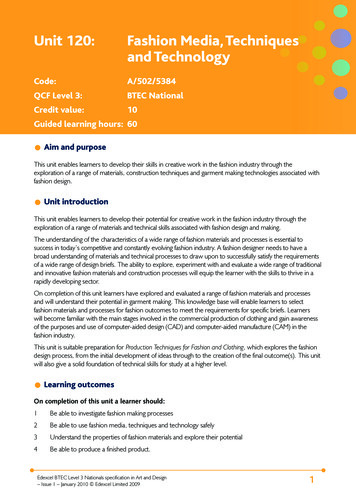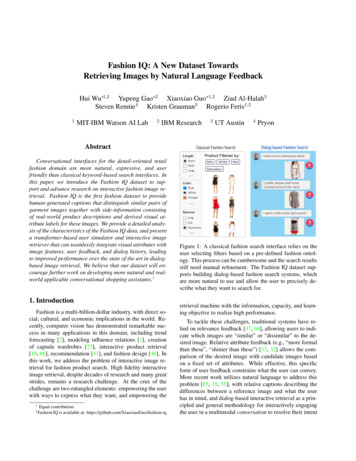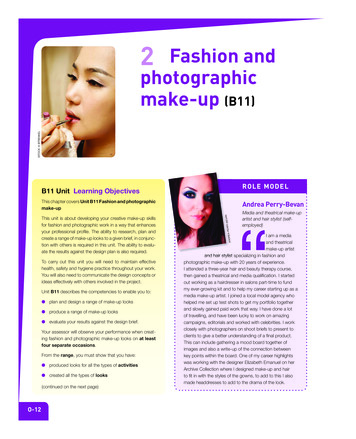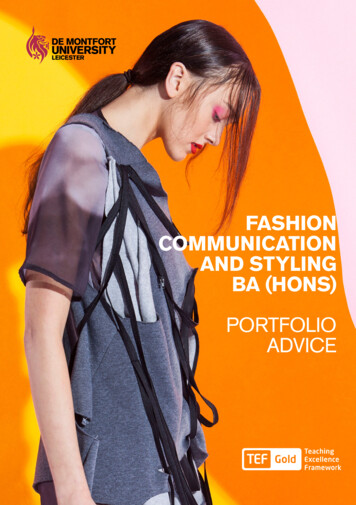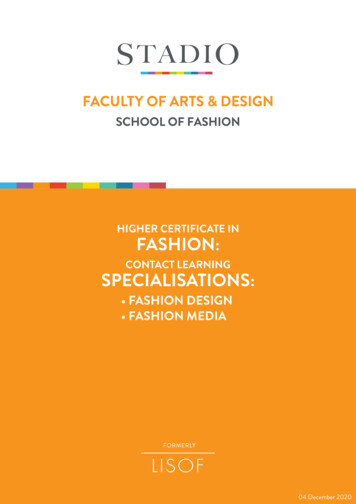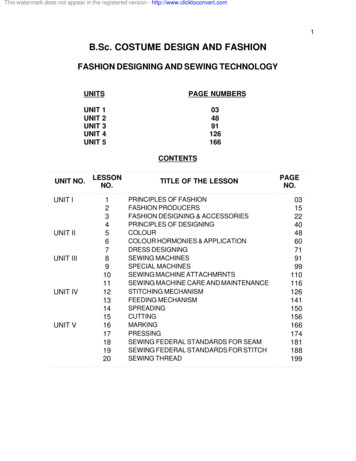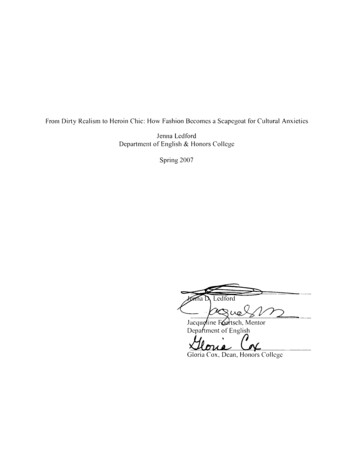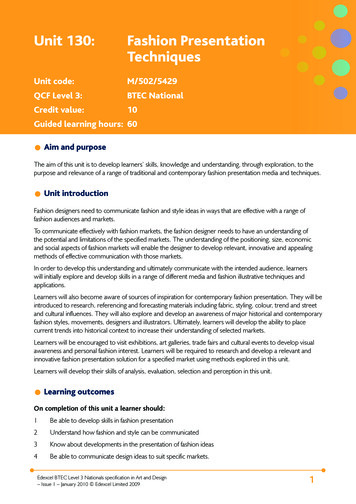
Transcription
Unit 130:Fashion PresentationTechniquesUnit code:M/502/5429QCF Level 3:BTEC NationalCredit value:10Guided learning hours: 60Aim and purposeThe aim of this unit is to develop learners’ skills, knowledge and understanding, through exploration, to thepurpose and relevance of a range of traditional and contemporary fashion presentation media and techniques.Unit introductionFashion designers need to communicate fashion and style ideas in ways that are effective with a range offashion audiences and markets.To communicate effectively with fashion markets, the fashion designer needs to have an understanding ofthe potential and limitations of the specified markets. The understanding of the positioning, size, economicand social aspects of fashion markets will enable the designer to develop relevant, innovative and appealingmethods of effective communication with those markets.In order to develop this understanding and ultimately communicate with the intended audience, learnerswill initially explore and develop skills in a range of different media and fashion illustrative techniques andapplications.Learners will also become aware of sources of inspiration for contemporary fashion presentation. They will beintroduced to research, referencing and forecasting materials including fabric, styling, colour, trend and streetand cultural influences. They will also explore and develop an awareness of major historical and contemporaryfashion styles, movements, designers and illustrators. Ultimately, learners will develop the ability to placecurrent trends into historical context to increase their understanding of selected markets.Learners will be encouraged to visit exhibitions, art galleries, trade fairs and cultural events to develop visualawareness and personal fashion interest. Learners will be required to research and develop a relevant andinnovative fashion presentation solution for a specified market using methods explored in this unit.Learners will develop their skills of analysis, evaluation, selection and perception in this unit.Learning outcomesOn completion of this unit a learner should:1Be able to develop skills in fashion presentation2Understand how fashion and style can be communicated3Know about developments in the presentation of fashion ideas4Be able to communicate design ideas to suit specific markets.Edexcel BTEC Level 3 Nationals specification in Art and Design– Issue 1 – January 2010 Edexcel Limited 20091
Unit content1 Be able to develop skills in fashion presentationMark-making techniques and media: drawing; painting; mixed media, collage; media eg pencil, fine-liner,pen, ink, marker, charcoal, oil and chalk pastel, gouache, watercolour, acrylic, oilTechniques and technologies: photography eg colour, black and white, digital; computer aided design(CAD); scanning and manipulation; printing eg screen, photocopyPresentation methods: theme and mood boards; design development sheets; sketchbook developmentwork; working drawings; final presentation boards2 Understand how fashion and style can be communicatedContemporary trends in fashion information: forecasting; fabrics, style, colour, theme, mood; street style;cultural influencesFashion communication media: newspapers; magazines; fashion magazines; forecasting publications; TVprogrammes; news media; retail outlets; internet sites; fashion shows; filmContemporary fashion presentation: new trend presentation eg analysis of colour, composition, proportion,typeface, layout, references to the work of other practitioners, contemporary and historical3 Know about developments in the presentation of fashion ideasHistorical and contemporary fashion presentation methods: fashion illustration eg Victorian fashion plates;fashion magazines eg Vogue in the 1950s; fashion writing eg news media, books, visual imagery, posters,billboards; fashion photography eg Cecil Beaton, David Bailey, Anthony Armstrong Jones, Mario TestinoMajor fashion styles: 19th and 20th century fashion movements eg Paris couture, Surrealism, The NewLookRelationship of fashion styles to cultural trends: eg ‘The Space Age’, ‘Punk’, ‘Glam Rock’, ‘Grunge’; howstreet style influences the catwalkInfluence of art movements on fashion developments: eg Diaghilev’s Ballets Russes, Cubism, Surrealism,space exploration of the 1960s and 70s, Op Art, Pop Art4 Be able to communicate design ideas to suit specific marketsMarket awareness: market level; segment eg children’s wear, bridal, leisure wear (ladies’ and men’s), highstreet (low, medium and high ends), coutureAppropriate media: format eg mood boards, presentation board, poster, digital eg presentation, web page2Edexcel BTEC Level 3 Nationals specification in Art and Design– Issue 1 – January 2010 Edexcel Limited 2009
Assessment and grading criteriaIn order to pass this unit, the evidence that the learner presents for assessment needs to demonstrate thatthey can meet all the learning outcomes for the unit. The assessment criteria for a pass grade describe thelevel of achievement required to pass this unit.Assessment and grading criteriaTo achieve a pass grade theevidence must show that thelearner is able to:To achieve a merit grade theevidence must show that, inaddition to the pass criteria,the learner is able to:To achieve a distinction gradethe evidence must show that,in addition to the pass andmerit criteria, the learner isable to:P1present fashion items usingmedia, techniques andillustration methods[IE CT, RL]M1 carry out and present aD1well-organised record ofthe sustained and systematicinvestigation of own andothers’ work using a range ofmedia, techniques, illustrationmethods and stylesP2explain ways in whichfashion and style can becommunicated[CT, EP]M2 show an individualand diverse style forcommunicating fashion ideas.P3describe developments in thepresentation of fashion ideas[IE, CT, RL]P4communicate design ideas tosuit specific markets.[CT, EP]show an independent,informed and excitingapproach to communicatingfashion ideas that thoroughlyexploits the potential andlimitations of the techniquesused and is attractive tospecialised markets.PLTS: This summary references where applicable, in the square brackets, the elements of the personal,learning and thinking skills applicable in the pass criteria. It identifies opportunities for learners to demonstrateeffective application of the referenced elements of the skills.KeyIE – independent enquirersRL – reflective learnersSM – self-managersCT – creative thinkersTW – team workersEP – effective participatorsEdexcel BTEC Level 3 Nationals specification in Art and Design– Issue 1 – January 2010 Edexcel Limited 20093
Essential guidance for tutorsDeliveryTutors should engage learners through a range of practical demonstrations. These sessions will provide theunderpinning, understanding, awareness and skills of the way fashion ideas may be presented effectively fora specific market or purpose. Typically this would be through project briefs that reflect current professionalpractice. Learners also need the opportunity to engage in practical exploration of a range of media andtechniques both within a guided environment and independently.Learning outcome 1 explores traditional and innovative techniques and technologies. Initially this outcomecould be delivered by group discussion and practical demonstration of the potential and limitations of a rangeof media, methods and materials. An inspiring presentation of images of the initial design work of fashiondesigners and examples of the presentation of fashion ideas would be a useful part of a sound introduction tothe project brief.Learners need to evaluate their own practical exploration of media, techniques and materials in the form ofevaluative notes, within a sketchbook or on worksheets. Alternatively, learners may evaluate their work inaudio form that clearly links to practical exploratory work. Additionally, learners should be encouraged to takepart in, and document, peer group review and appraisal sessions with staff and other learners.Tutors need to introduce learners to a range of presentation methods to explore the purpose and functions ofdifferent ways of presenting fashion ideas. A presentation of examples of fashion presentation techniques and agroup discussion may be a useful method of delivery. Additionally learners require the opportunity to explorespecific examples of a range of fashion presentation methods.Learning outcome 2 explores different ways fashion and style can be communicated. Learners need access toa wide variety of examples of contemporary fashion presentation methods. Tutors will need to assist learnersto analyse the functions and purposes of a range of fashion presentation methods. Learners need to analysedifferent market segments and fashion audiences. Tutors may find it useful to give learners specific areas tofocus on and investigate, such as the markets that specific fashion brands target, the size of those markets andthe purposes of particular campaigns, for example the promotion of a specific label or fashion style.Learning outcome 3 explores the evolution of fashion communication methods. Tutors may find it useful toprovide learners with an overview of the main developments in fashion presentation from the developmentof Victorian fashion plates, fashion magazines and newspapers. Learners should be given the opportunityto explore the development of fashion illustration and photography. The impact of fashion ideas promotedthrough television and digital media and through popular music culture should be explored. Learners needto explore and analyse the cultural and technical contexts of examples of a range of fashion communicationmethods.Learning outcome 4 gives learners the opportunity to communicate fashion ideas to suit specific markets.Tutors may find it useful to discuss examples of different markets and the relevance of specific presentationmethods with learners. Learners need to identify and analyse a specific target market, the fashion ideathey wish to promote, and select appropriate presentation methods. Learners need to develop a fashionpresentation solution that communicates clearly with the identified audience.4Edexcel BTEC Level 3 Nationals specification in Art and Design– Issue 1 – January 2010 Edexcel Limited 2009
Outline learning planThe outline learning plan has been included in this unit as guidance and can be used in conjunction with theprogramme of suggested assignments.The outline learning plan demonstrates one way in planning the delivery and assessment of this unit.Topic and suggested assignments/activities and/assessmentIntroduction to unit.Introduction to fashion communication.Introduction to use of different media, fashion illustration, and presentation techniques and processes.Application of media techniques – short tasks.Assignment 1: Fashion PresentationStage 1: SketchbookVisit to exhibition/gallery/museum – exercise in recording and sketching using a range of media and techniques.Fashion illustration techniques – short tasks.Stage 2: Fashion illustrationLearners individually: learners research a range of fashion magazines and fashion photographs produce three fashion illustrations using a range of media for three different markets analyse and discuss findings with group.Application of presentation techniques – short tasks.Introduction to research, referencing and forecasting material.Stage 3: Fashion predictionLearners: learners research to produce fashion report analysis on forthcoming season produce trend/style forecasting board for specific market/season.Introduction to historical and contextual influencers.Stage 4: Historical and contextual notebookLearners: collect and select key fashion influencers over a specific decade produce visual notebook analyse and evaluate findings produce visual and word-processed report.Edexcel BTEC Level 3 Nationals specification in Art and Design– Issue 1 – January 2010 Edexcel Limited 20095
Topic and suggested assignments/activities and/assessmentStage 5: Fashion communication report.Learners research and develop a relevant and innovative fashion presentation solution for a specified marketusing methods explored in previous assignments.Learners: research a specific market produce style/trend board produce finished fashion illustration for specific media produce report present findings and review.Review of unit and assessment.AssessmentFor P1, learners need to demonstrate the ability to select and use appropriate media techniques illustrationmethods. They need to support their practical work with appropriate explanatory and analytical evaluation.This evidence may take the form of exploration of different ways of illustrating selected fashion images using arange of traditional and digital media in a sketchbook or notebook format or a series of work or design sheets.Learners need to demonstrate awareness of a range of presentation methods and the purpose of differenttypes of presentations. Evidence may take the form of theme or mood boards, design development sheets,sketchbook work, working drawings or presentation boards and appropriate explanatory and analyticalevaluation.To achieve P2, learners need to explain contemporary trends and presentation styles in fashion. Evidence maytake the form of a research folder with written explanations.For P2, learners will need to understand different ways in which fashion and style can be communicated.Evidence for this criterion may take the form of examples of a selection of presentation methods andaccompanying analytical annotation, in the form of a mood boards, colour boards or work sheets.To achieve P3, learners must provide evidence of understanding of historical and contemporary developmentsin art and design on the presentation of fashion ideas. This may take the form of examples of a range ofmethods of presenting fashion ideas and accompanying analysis of the cultural and technical contexts ofchosen presentation examples. This research may be presented in the form of an organised resource (files,sketchbooks, onscreen presentation).To achieve P4, learners need to communicate design ideas to suit specific markets. Learners must identifytheir selected market and the fashion trend they wish to promote to the selected market. They need toshow evidence, in the form of a relevant presentation and evaluation, of the selection of appropriate media,materials and techniques.To achieve M1, learners must carry out and present a well-organised record of the sustained and systematicinvestigation of their own and others’ use of a range of media, techniques, illustration methods and styles. Atthis level, learners will be expected to demonstrate an increasingly independent and experimental approachto their research and development work.For M2, learners must show an individual style for communicating fashion ideas in a way that is relevant to aspecified market, through using the results of investigations to inform presentation decisions. Learners shouldpresent in-depth research and development of a fashion presentation solution for an identified market.6Edexcel BTEC Level 3 Nationals specification in Art and Design– Issue 1 – January 2010 Edexcel Limited 2009
For D1, learners are required to show an individual, informed and exciting approach to communicatingfashion ideas that exploits the potential and limitations of the techniques and is attractive to a specialisedmarket. Work should be supported by independent research into historical and contemporary developments.Outcomes should show an informed understanding of the selected market and evidence of the ability togenerate exciting and effective fashion presentation solutions.Programme of suggested assignmentsThe table below shows a programme of suggested assignments that cover the pass, merit and distinctioncriteria in the assessment and grading grid. This is for guidance and it is recommended that centres eitherwrite their own assignments or adapt any Edexcel assignments to meet local needs and resources.Criteria coveredAssignment titleScenarioP1, P2, P3, P4Assignment 1:Designer visits art gallery/Sketch/ideas book.museum and produces visualVisual research.notebook.Fashion illustrations.Designer researches andPresentation (recorded).produces three fashionillustrations in varying stylesVisual research report.and media appropriate toStory/trend boards.specific market.M1, M2Fashion PresentationD1Assessment methodDesigner researchesproduces and reportswritten and visual materialfor specific season.Links to National Occupational Standards, other BTEC units, other BTECqualifications and other relevant units and qualificationsThis unit forms part of the BTEC Art and Design sector suite. This unit has particular links with the followingunit titles in the BTEC Art and Design suite:Level 1Level 2Level 3Introduction to Fashion Marketingand PromotionWorking with Fashion BriefsFashion MarketingIntroduction to Creative Use ofComputersWorking with Accessory BriefsFashion VisualisationAn Introduction to the FashionIndustryComputer Applications in FashionFashion PromotionEdexcel BTEC Level 3 Nationals specification in Art and Design– Issue 1 – January 2010 Edexcel Limited 20097
National Occupational StandardsThis unit also provides development opportunities for some of the underpinning skills, knowledge andunderstanding of the following National Occupational Standards:Skillfast-UK Sector Skills CouncilTextiles and Material Design D1 Research design information and ideas for textiles and materials using a range of techniques D15 Plan and contribute to the realisation of final textile and material design.Essential resourcesLearners require access to a learning resource centre which is stocked with books, contemporaryfashion magazines and journals, trade journals, trend information, CD ROM databases and websites oncontemporary and historical fashion design, fashion illustration, fashion photography and fashion in film.Learners require access to studio or workshop spaces equipped with traditional, innovative and electronicmedia and materials.Employer engagement and vocational contextsCentres should develop links with practising fashion designers, to deliver assignments to learners or to providework experience.Links with employers are essential to the delivery of the programme for work experience and futureemployment.Vocational learning support resources: Learning and Skills Network – www.vocationallearning.org.ukBusiness and finance advice: local and regional Business Link – www.businesslink.gov.ukAssignments should be vocationally relevant; centres should consider the delivery of ‘live projects’, forexample, to support the vocational content of the unit and programme.Creative and Cultural Skills (www.ccskills.org.uk), the Sector Skills Council for Arts, Crafts and Design,has launched the web portal Creative Choices (www.creative-choices.co.uk). This portal has a range ofinformation about careers in the arts, crafts and design sector, including job descriptions.Skillfast-UK, the Sector Skills Council for Fashion and Textiles (www.skillfast-uk.org), provides details oncareers (www.skillfast-uk.org/justthejob) and the industry and has regularly updated news and events pages.8Edexcel BTEC Level 3 Nationals specification in Art and Design– Issue 1 – January 2010 Edexcel Limited 2009
Indicative reading for learnersTextbooksBlum S – Designs by ‘Erte’: Fashion Drawings and Illustrations from ‘Harper’s Bazaar’ (Dover Publications, 1977)ISBN 978-0486233970Burke S – Fashion Artist: Drawing Techniques to Portfolio Presentation (Fashion Design Series) (Burke Publishing,2006) ISBN 978-0958239172Borrelli L – Fashion Illustration Now (Thames & Hudson, 2000) ISBN 978-0810991231Dawber M – Imagemakers: Cutting Edge Fashion Illustration (Mitchell Beazley, 2004) ISBN 978-1840009835Dawber M – New Fashion Illustration (Batsford, 2005) ISBN 978-0713489613Grafton C – Fashions of the Thirties (Dover Publications, 2006) ISBN 978-0486275802Hyland A and Bell R – Hand to Eye: Contemporary Illustration (Laurence King Publishing, 2003)ISBN 978-1856693394Ireland J – Figure Templates for Fashion Illustration (Batsford, 2002) ISBN 978-0713485721Lafuente M – Fashion Illustration Techniques (Taschen, 2008) ISBN 978-3836504072Peacock J – The Complete Fashion Sourcebook: 2000 Illustrations Charting 20th-Century(Thames & Hudson, 2005) ISBN 978-0500512760Watanabe N – Contemporary Fashion Illustration Techniques (Rockport Publishers, 2009)ISBN 978-1592535569Wintour A et al – Manolo Blahnik Drawings (Thames & Hudson, 2009) ISBN 978-0500288092Websiteswww.lolc.co.ukLand of Lost Content: Student fashion mFashion Illustration Gallery: Art by fashion illustratorsEdexcel BTEC Level 3 Nationals specification in Art and Design– Issue 1 – January 2010 Edexcel Limited 20099
Delivery of personal, learning and thinking skills (PLTS)The following table identifies the PLTS that have been included within the assessment criteria of this unit:SkillWhen learners are Independent enquirersinvestigating their own and others’ workCreative thinkersusing a range of media, techniques and illustrative stylesReflective learnersreviewing their own and others work and acting on outcomes to improve anddevelop skills and knowledgeSelf-managersorganising time and resources to develop skills and complete project briefsEffective participatorsdiscussing and participating in presentation critiques.Although PLTS are identified within this unit as an inherent part of the assessment criteria, there are furtheropportunities to develop a range of PLTS through various approaches to teaching and learning.SkillWhen learners are Independent enquirersresearching fashion illustrative styles, historical and contextual influencersresearching specified markets, trends and stylesCreative thinkersproducing a variety of visual boards, notebooks, sketchbooks and drawingsReflective learnersanalysing and evaluating work and findingsSelf-managersdeveloping relevant and innovative fashion presentation solutions for a specifiedmarketEffective participatorsactively participating in presentations and group discussions.10Edexcel BTEC Level 3 Nationals specification in Art and Design– Issue 1 – January 2010 Edexcel Limited 2009
Functional Skills – Level 2SkillWhen learners are ICT – Use ICT systemsSelect, interact with and use ICT systemsindependently for a complex task to meet avariety of needsresearching fashion illustrative stylesUse ICT to effectively plan work andevaluate the effectiveness of the ICT systemthey have usedplanning fashion presentationsICT – Find and select informationSelect and use a variety of sources ofcreating and finding illustrative materialsinformation independently for a complex taskAccess, search for, select and use ICTexploring specific software, techniques and web basedbased information and evaluate its fitness for informationpurposeICT – Develop, present andcommunicate informationBring together information to suit contentand purposepresenting analysed work in word processed formatPresent information in ways that are fit forpurpose and audiencepresenting completed work for specific marketSelect and use ICT to communicate andexchange information safely, responsibly andeffectively including storage of messages andcontact listsemailing tutor and peer groupEnglishSpeaking and listening – make a range ofcontributions to discussions and makeeffective presentations in a wide range ofcontextsReading – compare, select, read andunderstand texts and use them to gatherinformation, ideas, arguments and opinionsWriting – write documents, includingextended writing pieces, communicatinginformation, ideas and opinions, effectivelyand persuasivelyparticipating in group discussionspresenting work in a variety of formats – group presentations,word processed reportswriting reports.Edexcel BTEC Level 3 Nationals specification in Art and Design– Issue 1 – January 2010 Edexcel Limited 200911
of Victorian fashion plates, fashion magazines and newspapers. Learners should be given the opportunity to explore the development of fashion illustration and photography. The impact of fashion ideas promoted through television and digital media and throug
